Nepal Gundruk Recipe: Gundruk is a beloved dish from Nepal that captures the essence of local flavors and traditions. This simple yet nutritious recipe features fermented leafy greens, typically mustard and radish leaves, making it a staple in many Nepali households. We’ve explored various cooking classes and local restaurants to bring you an authentic way to prepare this delightful dish.
As we traveled through Nepal, we learned that Gundruk is not only cherished for its taste but also for its health benefits. The fermentation process enhances the greens’ nutritional profile, making it a fantastic addition to any meal. We’re excited to share our take on this popular recipe, which is steeped in history and vibrant flavor.
Join us as we guide you through the steps to create your own Gundruk at home. With its unique flavors and rich cultural background, this dish promises to be an exciting experience for your tastebuds.
About Us
We are John and Laurel Rodgers, an American couple passionate about exploring global cuisines.
Our journey takes us around the world. We visit local restaurants and participate in cooking classes. This allows us to gather authentic recipes and share our culinary discoveries with you.
We believe that food tells a story. Each recipe preserves cultural heritage and brings people together. With every dish we explore, we aim to offer insights into the traditions and flavors that define it.
Our love for cooking and travel inspires us to connect with communities through food. We hope to inspire you to try these recipes in your own kitchen, enriching your meals with new tastes and experiences.
We are excited to share the recipe for Gundruk, a beloved Nepali dish. Join us as we dive into the flavors and techniques that make this dish a staple in Nepalese homes. Enjoy cooking with us as we explore diverse food landscapes!
Why You’ll Love This Nepal Gundruk Recipe
We believe you’ll appreciate this Nepal Gundruk recipe for several reasons.
Unique Flavor
Gundruk has a distinct tangy flavor that comes from fermenting leafy greens. This makes the dish flavorful and full of character.
Simple Ingredients
You don’t need many ingredients to prepare Gundruk. Just a few vegetables, water, and basic spices can create a delicious meal.
Versatile Dish
Gundruk can be enjoyed in various ways. Whether in a soup, as a side dish, or in a salad, it adapts well to different meals.
Healthy Option
Fermented foods like Gundruk are known for their health benefits. They can aid digestion and provide essential vitamins.
Cultural Experience
Making and enjoying Gundruk connects us with Nepali culture. It’s a central part of their cooking, allowing us to explore new traditions.
Easy to Make
Even if you’re not an expert cook, this recipe is straightforward. Step-by-step instructions ensure a tasty result without much hassle.
Perfect for Any Season
Gundruk can be served hot or cold, making it suitable for any time of the year. It’s comforting in winter and refreshing in summer.
We invite you to try this flavorful dish and enjoy its unique qualities. It’s a wonderful way to expand our culinary horizons together.
What Makes This Recipe Special
Gundruk is more than just a dish; it is a vital part of Nepali culture. We appreciate how this recipe highlights the use of fermented greens like mustard and radish leaves. The fermentation process not only preserves the greens but also enhances their flavor.
This ingredient provides several benefits:
- High Nutritional Value: Gundruk is rich in vitamins and minerals, making it a healthy choice.
- Unique Flavor: The fermentation adds a tangy taste that is distinct and delicious.
- Culinary Versatility: We can use Gundruk in soups, salads, and other dishes, making it adaptable for various meals.
The tradition of making Gundruk speaks to resourcefulness. In the mountainous regions of Nepal, people created this method to avoid wasting leafy greens. Dried and stored Gundruk ensures that families have access to nutritious food even during harsh conditions.
In our cooking, we love how Gundruk connects us to a community and a history. When we prepare this dish, we reflect on the rich cultural heritage of Nepal and the stories behind this beloved staple.
By using Gundruk, we bring a piece of Nepal into our kitchens. It allows us to share a unique part of Nepali cuisine with friends and family, enriching meals with flavor and tradition. This recipe exemplifies the blend of practicality and taste that defines many traditional foods.
Cooking Equipment Needed
To make a delicious Gundruk dish, we need some basic cooking equipment. Here’s a list to help you gather everything needed.
- Cooking Pot: A deep pot is essential for cooking soups or stews with Gundruk.
- Bowl: We use a bowl to soak Gundruk in water before cooking. This helps to wash it clean.
- Spatula or Stirring Spoon: A spatula will help us stir the ingredients while cooking.
Measuring Tools:
- Measuring Cups: They are important for measuring out water and other ingredients.
- Measuring Spoons: Useful for spices and oils.
Cutting Tools:
- Knife: A good knife is necessary for chopping vegetables and preparing ingredients.
- Cutting Board: We need a cutting board to safely chop our ingredients.
Serving Dishes:
- Serving Plate or Bowl: Once our Gundruk dish is ready, we will need a plate or bowl for serving.
With these tools, we will be well-prepared to create a tasty meal featuring Gundruk. Each piece of equipment plays a role in making our cooking experience smooth and enjoyable.
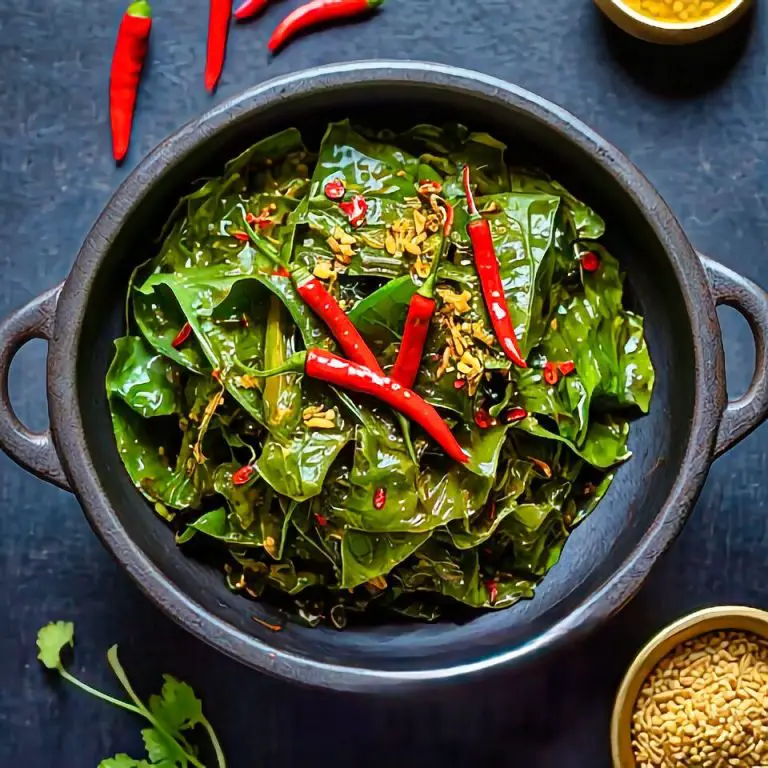
Cooking Instructions
To make Gundruk, we need to follow a few simple steps that bring out its unique flavors.
- Prepare the Gundruk: Start by boiling some water. Add the Gundruk and let it steep for about 10 minutes. After this, drain the water and squeeze out any excess liquid.
- Chop the Greens: Transfer the Gundruk to a cutting board. Carefully chop it into smaller pieces to make it easier to cook.
- Cook the Base: In a saucepan, heat mustard oil. Once hot, add sliced onions to sauté until they are golden brown.
- Combine Ingredients: Add the chopped Gundruk into the saucepan. Stir well to mix it with the onions.
- Seasoning: Add salt and any spices we like. We can also include soybean seeds for extra flavor.
- Simmer: Let everything simmer together for about 5-10 minutes. This helps the flavors blend well.
- Serve: Once cooked, we can serve Gundruk as a side dish or mix it into rice for a complete meal.
Feel free to adjust the seasoning to suit our taste. Enjoy cooking and tasting this traditional Nepali dish!
Cooking Tips
When making Gundruk, use fresh leafy greens like mustard or other greens. They should be clean and free of dirt.
Preparation Steps:
- Wash Thoroughly: Wash the greens in warm water to remove any dust or soil.
- Crushing: Crush the greens with stones to help with fermentation.
- Fermentation: Allow the greens to ferment in a clean, dry place. This process gives Gundruk its unique flavor.
For cooking, feel free to experiment with flavors. Here are some ideas:
- Broth: Add Gundruk to soups for a rich taste.
- Stir-fry: Toss it in a hot pan with oil, garlic, and other vegetables for a quick dish.
- Salads: Use it as a topping for salads for added texture.
When cooking Gundruk, remember to adjust the cooking time. It often requires about 10 minutes of steeping in boiling water when preparing for soup or stir-frying.
Storage Tips:
- Store dried Gundruk in an airtight container to keep it fresh.
- If you make a large batch, freeze any leftovers to enjoy later!
Ingredients For the Nepal Gundruk Recipe
Vegetable Oil
Gundruk Mustard Greens
Potato
Onion
Tomato
Garlic
Fresh Vhilli
Coriander Powder
Turmeric Powder
Salt
Coriander Leaves
Lemon Juice
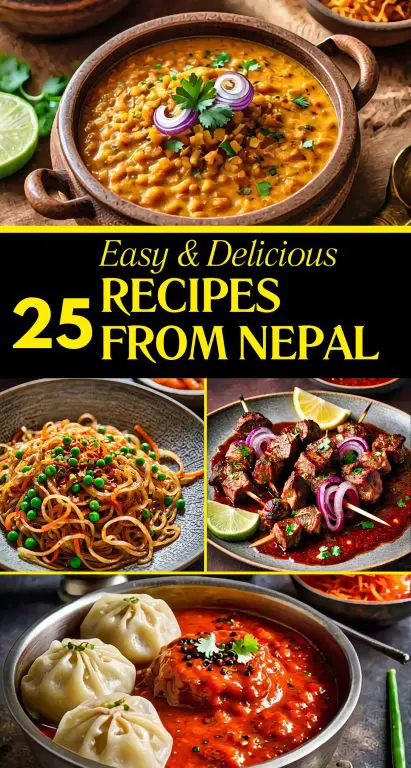
Cooking Instructions For the Nepal Gundruk Recipe
Preparing the Gundruk
Place the Gundruk in a bowl filled with hot water and let it soak for 15 minutes. Use this time to prepare the remaining ingredients. Once soaked, allow it to cool slightly, then squeeze out excess water. If any pieces are too large, chop them into 3-5 cm chunks to ensure even cooking.
Sautéing the Aromatics
Heat vegetable oil in a deep skillet or pan over medium heat. Add the chopped onions, stirring occasionally until they turn golden brown and release their aroma. Stir in the garlic slices, frying until they turn golden but not brown. Next, add the dry spices—turmeric and coriander powder—stirring constantly to prevent sticking and to enhance the flavors.
Cooking the Vegetables
Add the diced potatoes and fry briefly until they begin to soften, ensuring they are evenly coated with the spiced oil. Stir in the soaked Gundruk and chopped green chilies, mixing well for 1-2 minutes. Incorporate the diced tomatoes and salt, occasionally covering the pan to help the tomatoes break down. Once the tomatoes have softened, pour in 1 liter of water, including the liquid from the soaked Gundruk. Bring to a gentle boil, then reduce to a simmer, cover the pan, and let it cook for 10 minutes on low to medium heat.
Finishing Touches
Turn off the heat and squeeze in fresh lemon juice to enhance the flavors. Finally, sprinkle freshly chopped coriander leaves on top, adding a bright color and fresh herbal aroma to the dish.
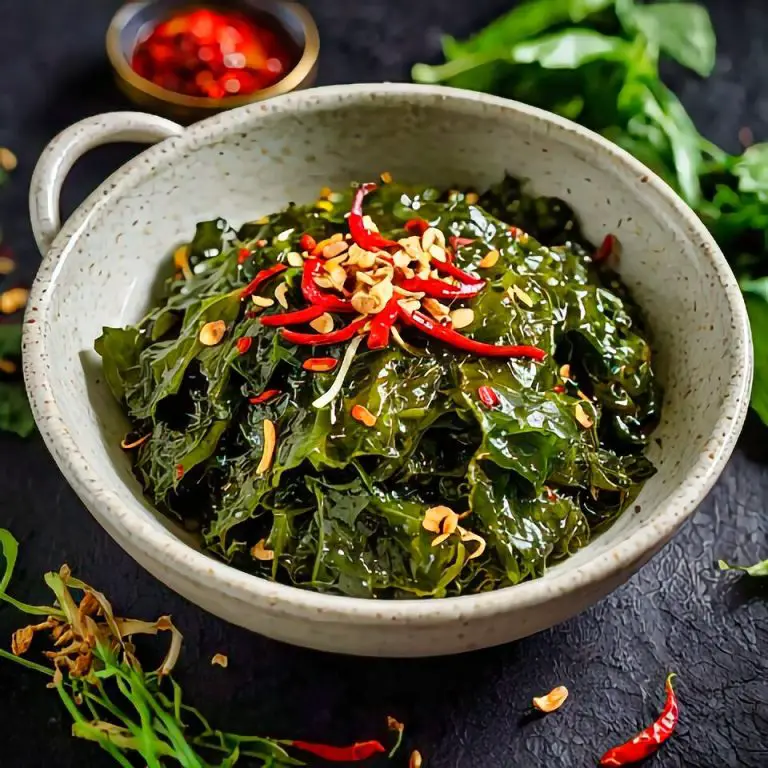
FAQ For the Nepal Gundruk Recipe
Question: What is the Nepal Gundruk recipe?
A: The Nepal Gundruk recipe is a traditional fermented leafy green dish made from mustard, radish, or cauliflower leaves. It is dried and used in soups, pickles, or curries, giving a distinct tangy and earthy taste to Nepalese meals.
Question: What ingredients are needed for the Nepal Gundruk recipe?
A: The Nepal Gundruk recipe requires fresh mustard, radish, or cauliflower leaves, which are fermented and dried. Additional ingredients for preparation may include tomatoes, garlic, ginger, chilies, turmeric, and mustard oil to enhance the taste.
Question: How is the Nepal Gundruk recipe prepared?
A: The Nepal Gundruk recipe is made by fermenting mustard or radish leaves for several days, then drying them under the sun. To cook, it is often sautéed with spices, added to soups, or mixed with pickles for a tangy and flavorful dish.
Question: Is the Nepal Gundruk recipe healthy?
A: The Nepal Gundruk recipe is highly nutritious, as it is rich in fiber, probiotics, and essential vitamins. The fermentation process enhances its nutritional value, making it a beneficial food for gut health and digestion.
Question: What makes the Nepal Gundruk recipe unique in Nepalese cuisine?
A: The Nepal Gundruk recipe is unique because it is one of the few naturally fermented and dried leafy green dishes in Nepalese cuisine. Its tangy flavor, long shelf life, and health benefits make it a staple in many households across Nepal.
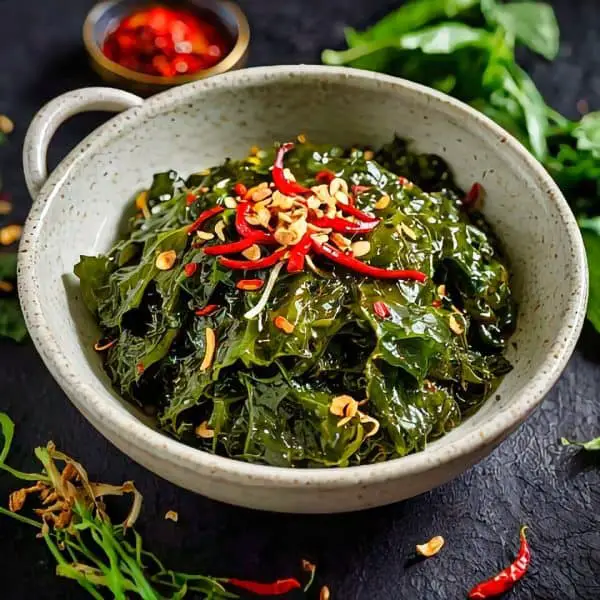
Nepal Gundruk Recipe
Ingredients
- 3 tbsp Vegetable Oil
- 4 oz Mustard Greens or other greens
- 1 Potato diced into small chunks
- 1 Onion medium-sized finely sliced
- 1 Tomato medium-sized roughly chopped
- 5 Garlic cloves finely sliced
- 1 Fresh Vhilli finely chopped
- ½ tsp Coriander Powder
- ½ tsp Turmeric Powder
- 1 tsp Salt
- 1/2 cup Coriander Leaves for garnishing
- 2 tbsp Lemon Juice
Instructions
Preparing the Gundruk
- Place the Gundruk in a bowl filled with hot water and let it soak for 15 minutes. Use this time to prepare the remaining ingredients. Once soaked, allow it to cool slightly, then squeeze out excess water. If any pieces are too large, chop them into 3-5 cm chunks to ensure even cooking.
Sautéing the Aromatics
- Heat vegetable oil in a deep skillet or pan over medium heat. Add the chopped onions, stirring occasionally until they turn golden brown and release their aroma. Stir in the garlic slices, frying until they turn golden but not brown. Next, add the dry spices—turmeric and coriander powder—stirring constantly to prevent sticking and to enhance the flavors.
Cooking the Vegetables
- Add the diced potatoes and fry briefly until they begin to soften, ensuring they are evenly coated with the spiced oil. Stir in the soaked Gundruk and chopped green chilies, mixing well for 1-2 minutes. Incorporate the diced tomatoes and salt, occasionally covering the pan to help the tomatoes break down. Once the tomatoes have softened, pour in 1 liter of water, including the liquid from the soaked Gundruk. Bring to a gentle boil, then reduce to a simmer, cover the pan, and let it cook for 10 minutes on low to medium heat.
Finishing Touches
- Turn off the heat and squeeze in fresh lemon juice to enhance the flavors. Finally, sprinkle freshly chopped coriander leaves on top, adding a bright color and fresh herbal aroma to the dish.

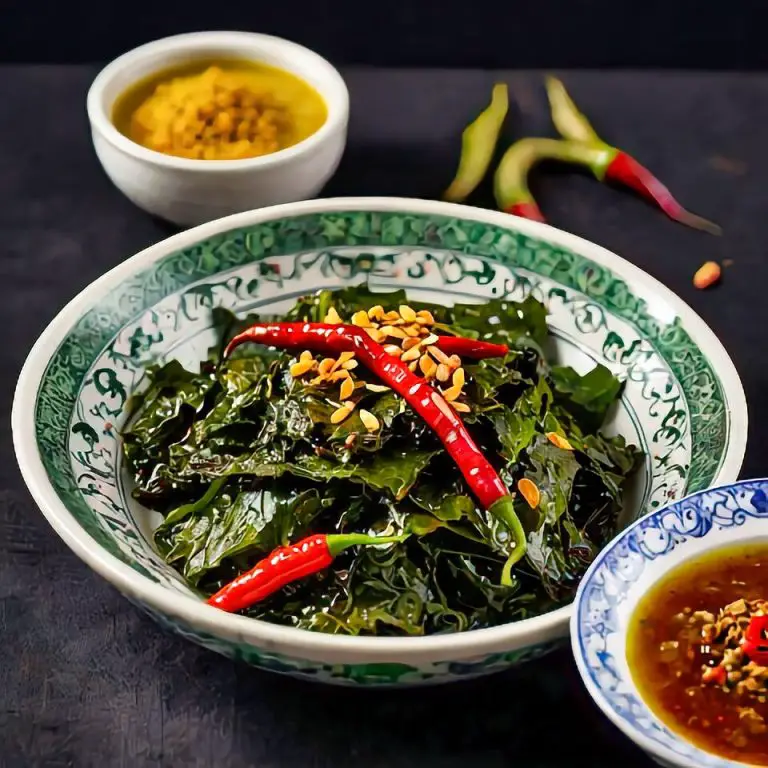
4 comments
I had never cooked with fermented greens before, but this dish was full of deep, earthy flavors! The mustard oil and chili gave it a slight heat, while the garlic added richness. It paired perfectly with rice. My guests said it had a great umami taste. Definitely worth making again!
I really enjoyed learning about the Nepal Gundruk Recipe! It got me thinking, though, do you think traditional recipes like this should be kept authentic, or is it okay to experiment with new ingredients and techniques?
Im not convinced that all these details about the Nepal Gundruk recipe are necessary. I mean, do we really need to know about the cooking equipment needed? Lets just get to the good stuff – the taste!
I cant help but wonder, does the type of cooking equipment really make a difference in how the Nepal Gundruk turns out? I mean, cant we just use whatever we have on hand? What do you guys think?